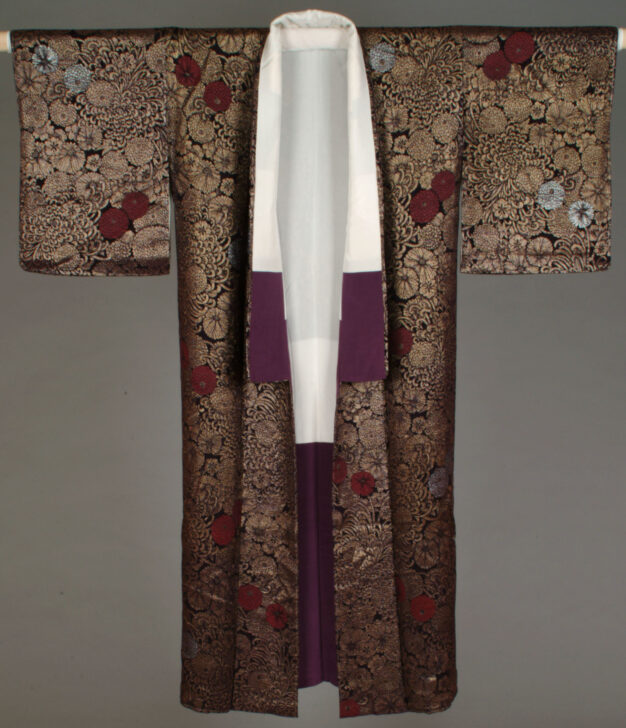Dark purple kimono with overall jacquard woven pattern of chrysanthemums in dark brown, silver, and gold
Japanese

Description
Kimono
Japan, Showa period (1926–1989)
circa 1930s–1950s
Silk crepe with interwoven brown, silver, and gold-coated threads
Gift of Howard and Patricia Yamaguchi, 2005/1.393
This kimono is one of several in the Yamaguchi Collection that were worn by Japanese business woman Iwata Shizuka (1899–1975) for informal occasions. Here, the chrysanthemum patterns are woven rather than hand painted. Though woven kimono can be quite labor-intensive and expensive to produce, they are nevertheless mostly used for casual wear. Over this kimono she would have worn a mid-thigh length jacket called a haori (an example is on view in this gallery) with a family crest, which made the ensemble appropriate for business. The combination of a woven kimono and haori creates a sense of formality similar to wearing a jacket and tie over a sporty shirt.
Gallery Rotation Spring/Summer 2012
Subject Matter:
This kimono is one of several in the Yamaguchi Collection that were worn by Iwata Shizuka for informal occasions. Here, the chrysanthemum patterns are woven rather than hand painted. Though woven kimono may be as labor-intensive and expensive to produce as hand-painted y?zen, they are mostly used for casual wear. Over this kimono she would have worn a haori (see haori in the gallery) with a family crest, which made it appropriate for business. The combination of a woven kimono and haori creates a sense of formality similar to wearing a jacket and tie over a sporty shirt. Iwata Shizuko vividly remembers her mother wearing haori to her office every day.
Physical Description:
Silk crepe repp with interwoven brown and silver- and gold-colored synthetic metallic threads in the design of chrysanthemum blossoms. Lining is plain weave silk for upper half; purple for lower half and inner cuffs.
Usage Rights:
If you are interested in using an image for a publication, please visit https://umma.umich.edu/request-image/ for more information and to fill out the online Image Rights and Reproductions Request Form.